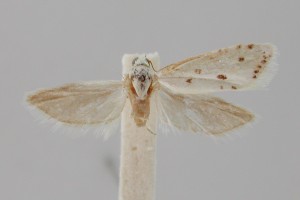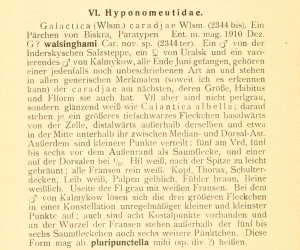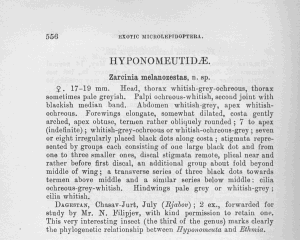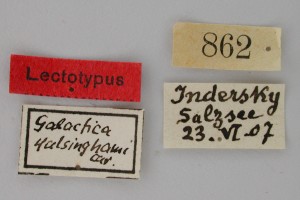

 +5Kontinente:EUAS
+5Kontinente:EUAS


2. Diagnose
2.1. Männchen
2.2. Erstbeschreibung und Beschreibung der ab. pluripunctella
2.3. Beschreibung als Zarcinia melanozestas
3. Biologie
3.1. Nahrung der Raupe
- [Plumbaginaceae:] Limonium gmelinii (Steppenschleier-Strandflieder)
Anikin et al. (2017) berichten zur Raupennahrung: "L: Limonium gmelinii in Omsk Distr. (pers. comm. of S. Knyazev)." Dazu passt der genannte Lebensraum: "Sandy and claw deserts, often near by watersometimes not rare but local." Mey (2022: ) schreibt zum gleichen Fundereignis: "The species was reared by Knyazev et al. (2016), who also described the larvae. The food plant was identified by as Limonium caspicus Willdenow, a species with a wide distribution around the northern part of the Caspian Sea to southern Siberia and Kazakhstan. The larvae live in webs spun throughout the affected leaves and flowers (Fig. 49). When fully crown the larvae spin cocoons between leaves and inflorescences of the host plant and overwinters in this stage. Judging from collecting dates of adults, the species probably has two generations per year."
4. Weitere Informationen
4.1. Andere Kombinationen
- Galactica walsinghami Caradja, 1920 [Originalkombination und bis Mey (2022) übliche Kombination]
4.2. Synonyme
- Galactica walsinghami ab. pluripunctella Caradja, 1920 [infrasubspecifisches Taxon]
- Galactica pluripunctella Caradja, 1920 [auf Artebene nie richtig beschrieben]
- Zarcinia melanozestas Meyrick, 1935
4.3. Taxonomie
Mey (2022) nimmt im Zusammenhang mit einer Revision der Familie Galacticidae die Neukombination mit Zarcinia vor.
Mey (2022) bestätigt die von Anikin et al. (2006: 466) vorgenommene Synonymisierung von Zarcinia melanozestas [als "Zarcinia melanocestas"] mit Zarzinia walsinghami. Galactica pluripunctella Caradja, 1920 wurde auf Artebene nie richtig beschrieben. Anikin et al. (2006: 466) vermerkten: "Status of this taxon describing as “ab. (sp. div.?)” of the preceding species is not clear. It is known after destroyed typical male specimens; but two different species of Galactica are found in Astrakhan Distr. therefore we considered here pluripunctella in a rank of a separate species; additional material should be useful to define its status more precisely. LT: Kalmykow." Anikin et al. (2017: 74) führen pluripunctella dann ohne weiteren Kommentar in der Synonymie von Z. walsinghami. In Europa gibt es damit nicht drei sondern nur eine einzige Art der Familie Galacticidae. Interessanterweise geht Mey (2022) nicht auf die von Anikin et al. (2017: 74) angekündigte "Galactica sp. nov. [...] Description of the species follows soon." ein. Sie sollte nach einem alten Beleg aus der Oblast Astrakhan erfolgen, scheint jetzt aber doch wieder Z. walsinghami zugeordnet zu werden.
4.4. Faunistik
Mey (2022: 180-181) listet die von ihm untersuchten Belege auf - darunter auch das Typenmaterial der Art und ihrer Synonyme: "Material examined. type material, lectotype ♂, Kazakhstan, “Indersky/Salzsee/23.vi.[19]07”[hand-written on white paper], genitalia slide G. Friese 862, (MGAB); Paralectotype ♂, “Uralsk/29.vi.[19]07”[hand-written on white paper], genitalia slide Friese 863 (MGAB); Holotype ♀, ab. pluripunctella, “Kalmykov/26.vi.[19]07”, genitalia slide G. Friese 861 (MGAB); Lectotype ♀ of Zarcinia melanozestas, genitalia slide 7475, (BMNH) [examined]; 1 ♀, South Kazakhstan, Kzyl-Orda, 170 m, 44°51'N, 65°31'E , 01.v.1993, leg. M. Danilevsky, ex. coll. Schintlmeister, genitalia slide Mey 01/04 (MfN); 2 ♂, 1 ♀, Kazakhstan, Atyrau Region, 47°16'N, 53°50'E, 9.v.2007, leg. Trofimova & Shovkoon (coll. Shovkoon); 1 ♂, Kazakhstan, Kyzyl-Orda region, Karatup peninsula of Aral Lake, 46°20'N, 59°43'E, 26.v.2006, leg. Trofimova & Shovkoon (coll. Shovkoon); 3 ♂, Kazakhstan, Mangistau, Ustyurt Nature Reserve, Karynzharyk Sand, Saksorka well, 43°17'N, 53°33'E, 5.v.2010, 580 m, leg. Knud Larsen, genitalia slide male 4151 KL (coll. K. Larsen); 1 ♂, Russia, Orenburg Region, Sol’-Ileck area, 50°38'N, 54°42'E, leg. Shovkoon (coll. Shovkoon)." Als Verbreitungsgebiet ergibt sich daraus: "Dagestan, eastern Russia, Kazakhstan."
Anikin et al. (2017: 74) führt die Art aktuell aus den Regionen Kalmykia, Astrakhan, und Orenburg an, mit Altangabe auch von der Typenlokalität Uralsk. Sinev (2021) führt die Art in seinem Katalog aus den Regionen 11 (Волго-Донской регион: Саратовская, Волгоградская и Ростовская области), 12 (Нижневолжский регион: Астраханская область, Республика Калмыкия), 14 (Восточно-Кавказский регион: Чеченская Республика, Республика Дагестан), 17 (Южно-Уральский регион: Республика Башкортостан, Оренбургская, Челябинская и Курганская области) und 20 (Южно-Западносибирский регион: Тюменская, Омская и Новосибирская области (без правобережья р. Обь), Алтайский край (Кулундинская степь)). Die Funde betreffen also den Südosten des europäischen Teils von Russland, Daghestan bis zum Nordkaukasus, den Süden des asiatischen Teils Russland und vor allem den europäischen und asiatischen Teil Kasachstans.
(Autor: Erwin Rennwald)
4.5. Literatur
- Anikin, V. V., Sachkov, S. A., Zolotuhin, V.V., Nedoshivina, S.V. & T.A. Trofimova (2006): "Fauna lepidopterologica Volgo-Uralensis" 150 years later: Changes and additions. Part 11. Epermenioidea, Yponomeutoidea, Choreutidae et Galacticidae (Insecta, Lepidoptera). — Atalanta 37 (3-4): 457-467.
- Anikin, V.V., Sachkov, S.A. & V.V. Zolotuhin (2017): "Fauna lepidopterologica Volgo-Uralensis": from P. Pallas to present days. — Proceedings of the Museum Witt Munich, Volume 7: 1-696; Munich and Vilnius.
- Erstbeschreibung: Caradja, A. (1920): Beitrag zur Kenntnis der geographischen Verbreitung der Mikrolepidopteren des palaearktischen Faunengebietes nebst Beschreibung neuer Formen. III. Teil. — Deutsche Entomologische Zeitschrift „Iris“ 34 (1-2): 75-179. Dresden.
- Mey, W. (2022): Taxonomic notes on Palearctic taxa of Galacticidae, a little-known family of Lepidoptera (Galacticoidea). — Nota Lepidopterologica, 45: 169–190. [zum open-access-Artikel auf pensoft.net]
- Beschreibung als Zarcinia melanozestas: Meyrick, E. (1935): Exotic Microlepidoptera 4 (18): 545-576. [London] (Taylor & Francis).





